Macroeconomic Analysis and Policy Assignment 2, RMIT University
VerifiedAdded on 2020/01/23
|10
|2714
|190
Homework Assignment
AI Summary
This economics assignment delves into macroeconomic principles, utilizing the IS-LM framework to analyze economic concepts and policies. The assignment begins with calculations of the expenditure multiplier, equilibrium income, and budget surplus, examining the relationship between government spending, taxation, and output. It then introduces the IS and LM curves, deriving equations for equilibrium interest rates and income, and exploring the impact of changes in consumption functions. The core of the assignment involves analyzing the Global Financial Crisis (GFC) using the IS-LM model, discussing the nature of the economic shocks, and evaluating the fiscal and monetary policy responses by the government and central bank, respectively. The assignment emphasizes understanding how economies function and respond to crises, providing a comprehensive overview of macroeconomic analysis and policy implementation.
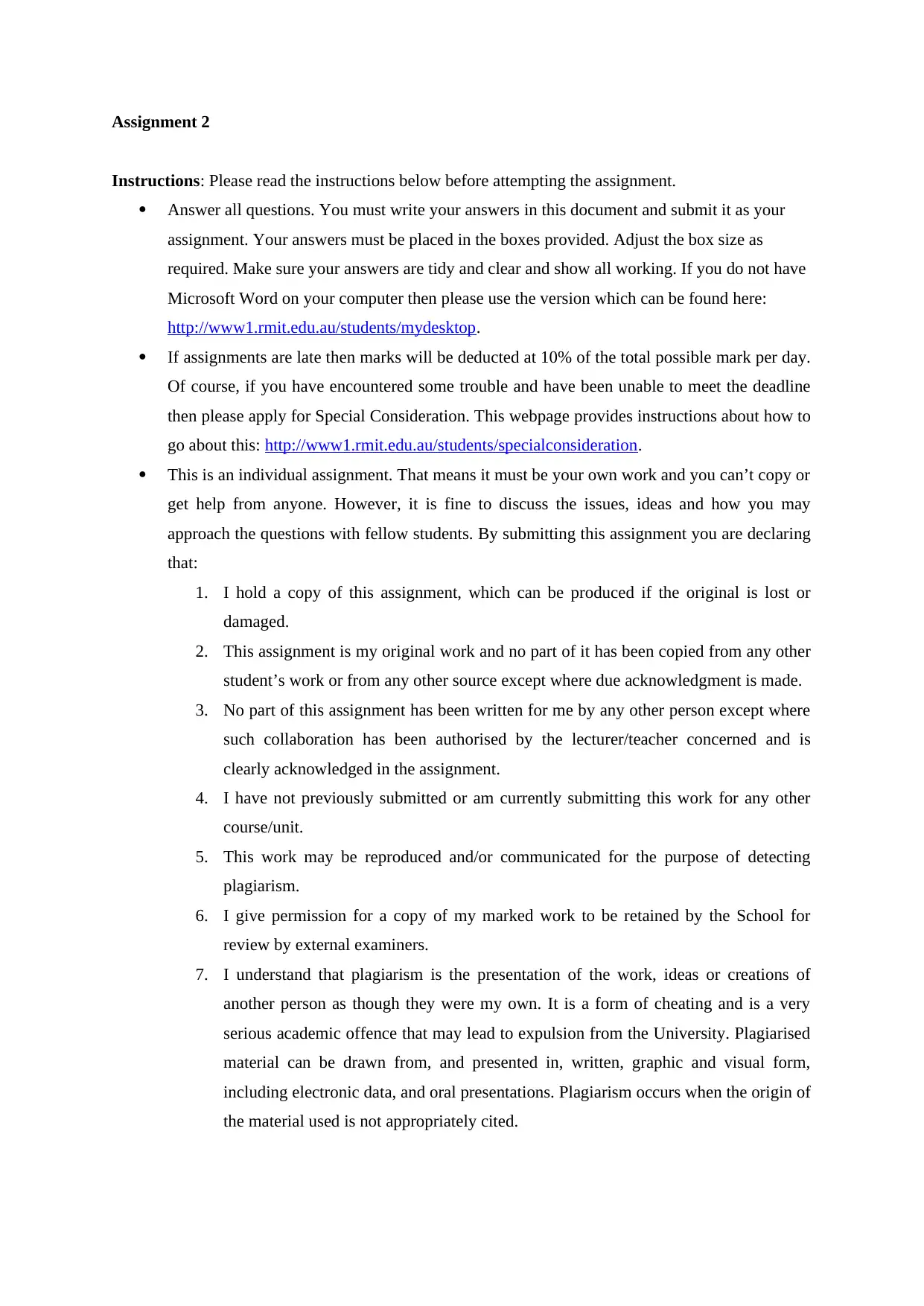
Assignment 2
Instructions: Please read the instructions below before attempting the assignment.
Answer all questions. You must write your answers in this document and submit it as your
assignment. Your answers must be placed in the boxes provided. Adjust the box size as
required. Make sure your answers are tidy and clear and show all working. If you do not have
Microsoft Word on your computer then please use the version which can be found here:
http://www1.rmit.edu.au/students/mydesktop.
If assignments are late then marks will be deducted at 10% of the total possible mark per day.
Of course, if you have encountered some trouble and have been unable to meet the deadline
then please apply for Special Consideration. This webpage provides instructions about how to
go about this: http://www1.rmit.edu.au/students/specialconsideration.
This is an individual assignment. That means it must be your own work and you can’t copy or
get help from anyone. However, it is fine to discuss the issues, ideas and how you may
approach the questions with fellow students. By submitting this assignment you are declaring
that:
1. I hold a copy of this assignment, which can be produced if the original is lost or
damaged.
2. This assignment is my original work and no part of it has been copied from any other
student’s work or from any other source except where due acknowledgment is made.
3. No part of this assignment has been written for me by any other person except where
such collaboration has been authorised by the lecturer/teacher concerned and is
clearly acknowledged in the assignment.
4. I have not previously submitted or am currently submitting this work for any other
course/unit.
5. This work may be reproduced and/or communicated for the purpose of detecting
plagiarism.
6. I give permission for a copy of my marked work to be retained by the School for
review by external examiners.
7. I understand that plagiarism is the presentation of the work, ideas or creations of
another person as though they were my own. It is a form of cheating and is a very
serious academic offence that may lead to expulsion from the University. Plagiarised
material can be drawn from, and presented in, written, graphic and visual form,
including electronic data, and oral presentations. Plagiarism occurs when the origin of
the material used is not appropriately cited.
Instructions: Please read the instructions below before attempting the assignment.
Answer all questions. You must write your answers in this document and submit it as your
assignment. Your answers must be placed in the boxes provided. Adjust the box size as
required. Make sure your answers are tidy and clear and show all working. If you do not have
Microsoft Word on your computer then please use the version which can be found here:
http://www1.rmit.edu.au/students/mydesktop.
If assignments are late then marks will be deducted at 10% of the total possible mark per day.
Of course, if you have encountered some trouble and have been unable to meet the deadline
then please apply for Special Consideration. This webpage provides instructions about how to
go about this: http://www1.rmit.edu.au/students/specialconsideration.
This is an individual assignment. That means it must be your own work and you can’t copy or
get help from anyone. However, it is fine to discuss the issues, ideas and how you may
approach the questions with fellow students. By submitting this assignment you are declaring
that:
1. I hold a copy of this assignment, which can be produced if the original is lost or
damaged.
2. This assignment is my original work and no part of it has been copied from any other
student’s work or from any other source except where due acknowledgment is made.
3. No part of this assignment has been written for me by any other person except where
such collaboration has been authorised by the lecturer/teacher concerned and is
clearly acknowledged in the assignment.
4. I have not previously submitted or am currently submitting this work for any other
course/unit.
5. This work may be reproduced and/or communicated for the purpose of detecting
plagiarism.
6. I give permission for a copy of my marked work to be retained by the School for
review by external examiners.
7. I understand that plagiarism is the presentation of the work, ideas or creations of
another person as though they were my own. It is a form of cheating and is a very
serious academic offence that may lead to expulsion from the University. Plagiarised
material can be drawn from, and presented in, written, graphic and visual form,
including electronic data, and oral presentations. Plagiarism occurs when the origin of
the material used is not appropriately cited.
Paraphrase This Document
Need a fresh take? Get an instant paraphrase of this document with our AI Paraphraser
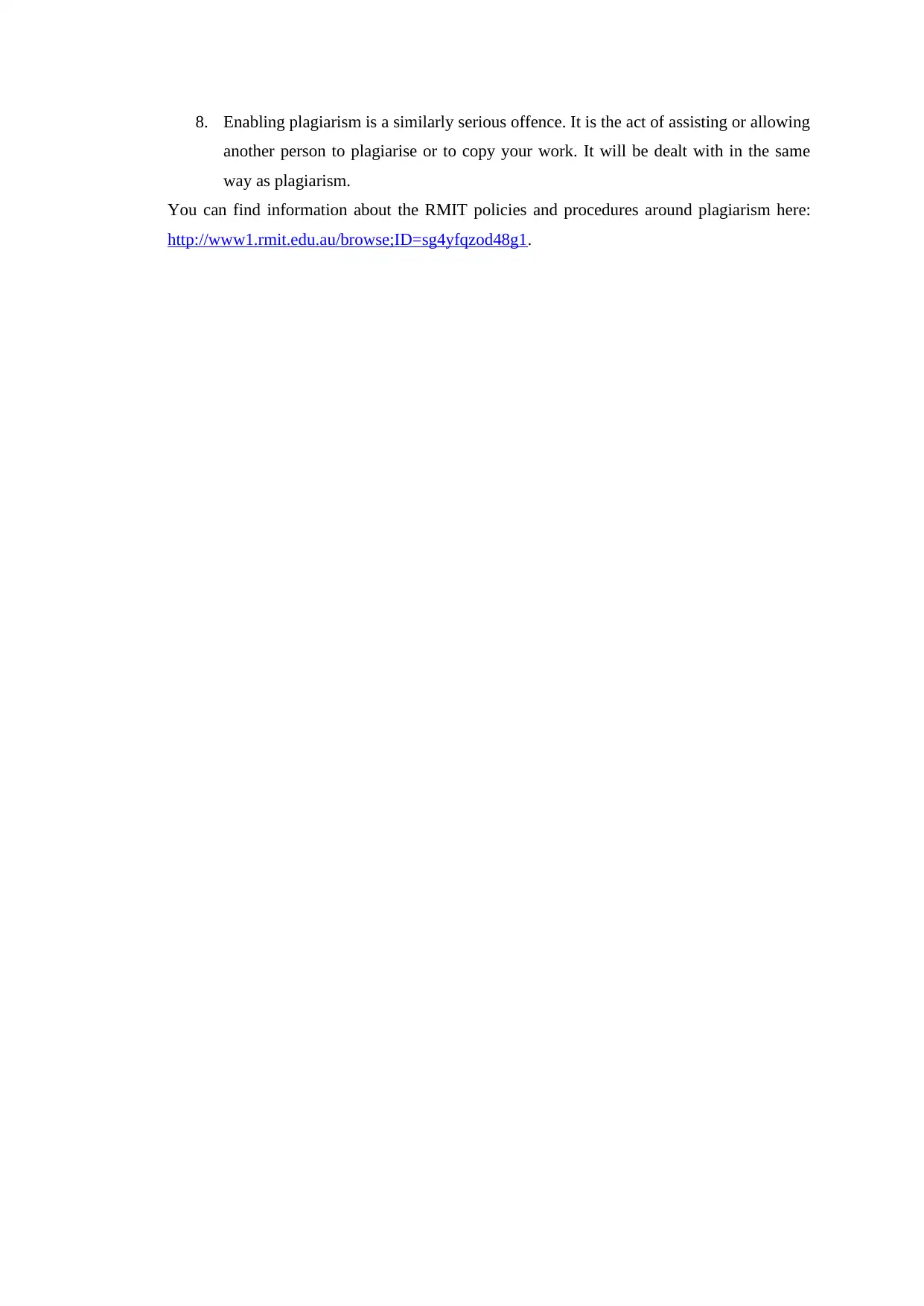
8. Enabling plagiarism is a similarly serious offence. It is the act of assisting or allowing
another person to plagiarise or to copy your work. It will be dealt with in the same
way as plagiarism.
You can find information about the RMIT policies and procedures around plagiarism here:
http://www1.rmit.edu.au/browse;ID=sg4yfqzod48g1.
another person to plagiarise or to copy your work. It will be dealt with in the same
way as plagiarism.
You can find information about the RMIT policies and procedures around plagiarism here:
http://www1.rmit.edu.au/browse;ID=sg4yfqzod48g1.
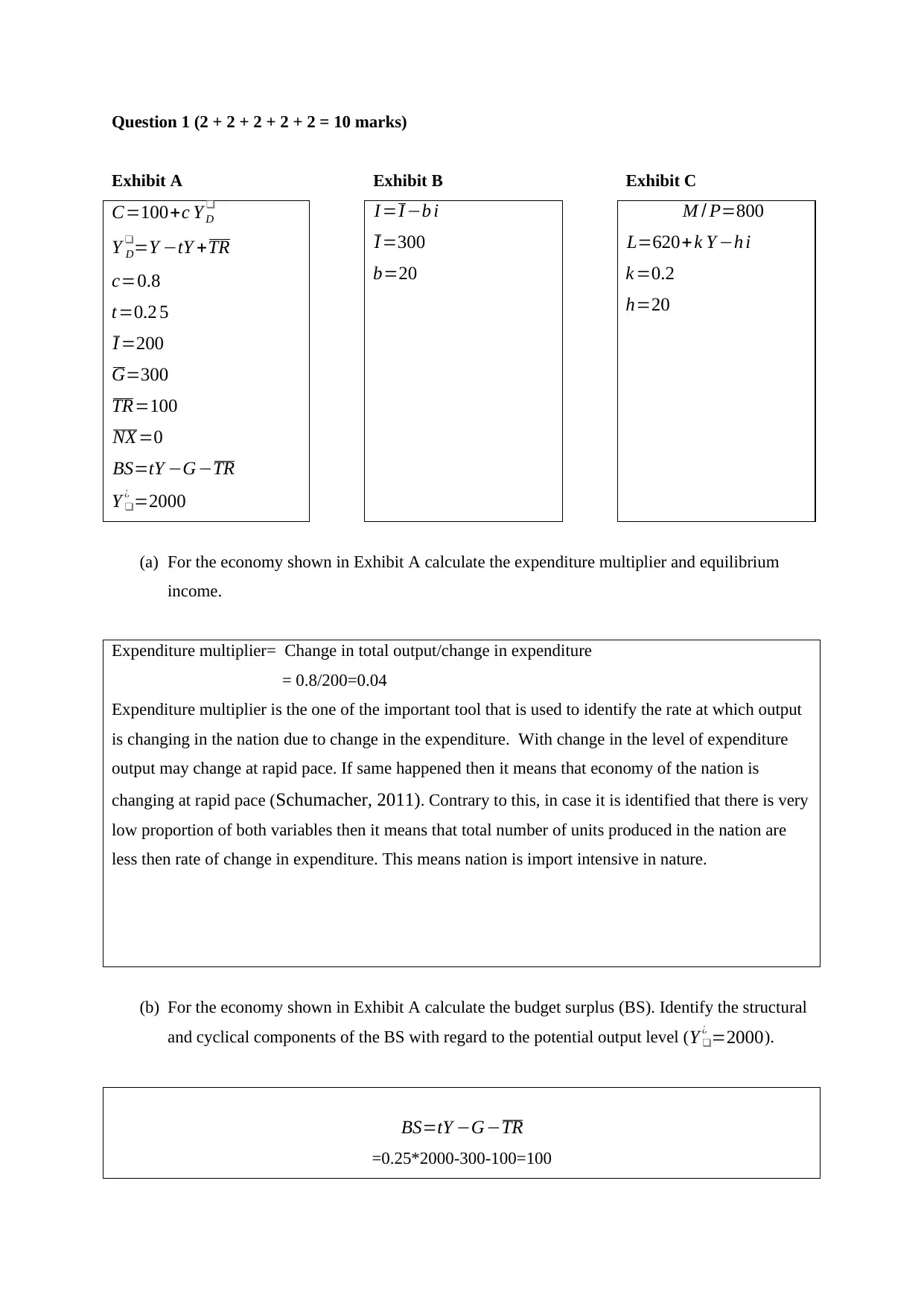
Question 1 (2 + 2 + 2 + 2 + 2 = 10 marks)
Exhibit A Exhibit B Exhibit C
C=100+c Y D
❑
Y D
❑=Y −tY +TR
c=0.8
t=0.2 5
I =200
G=300
TR=100
NX =0
BS=tY −G−TR
Y ❑
¿ =2000
I =I −b i
I =300
b=20
M / P=800
L=620+k Y −h i
k =0.2
h=20
(a) For the economy shown in Exhibit A calculate the expenditure multiplier and equilibrium
income.
Expenditure multiplier= Change in total output/change in expenditure
= 0.8/200=0.04
Expenditure multiplier is the one of the important tool that is used to identify the rate at which output
is changing in the nation due to change in the expenditure. With change in the level of expenditure
output may change at rapid pace. If same happened then it means that economy of the nation is
changing at rapid pace (Schumacher, 2011). Contrary to this, in case it is identified that there is very
low proportion of both variables then it means that total number of units produced in the nation are
less then rate of change in expenditure. This means nation is import intensive in nature.
(b) For the economy shown in Exhibit A calculate the budget surplus (BS). Identify the structural
and cyclical components of the BS with regard to the potential output level (Y ❑
¿ =2000).
BS=tY −G−TR
=0.25*2000-300-100=100
Exhibit A Exhibit B Exhibit C
C=100+c Y D
❑
Y D
❑=Y −tY +TR
c=0.8
t=0.2 5
I =200
G=300
TR=100
NX =0
BS=tY −G−TR
Y ❑
¿ =2000
I =I −b i
I =300
b=20
M / P=800
L=620+k Y −h i
k =0.2
h=20
(a) For the economy shown in Exhibit A calculate the expenditure multiplier and equilibrium
income.
Expenditure multiplier= Change in total output/change in expenditure
= 0.8/200=0.04
Expenditure multiplier is the one of the important tool that is used to identify the rate at which output
is changing in the nation due to change in the expenditure. With change in the level of expenditure
output may change at rapid pace. If same happened then it means that economy of the nation is
changing at rapid pace (Schumacher, 2011). Contrary to this, in case it is identified that there is very
low proportion of both variables then it means that total number of units produced in the nation are
less then rate of change in expenditure. This means nation is import intensive in nature.
(b) For the economy shown in Exhibit A calculate the budget surplus (BS). Identify the structural
and cyclical components of the BS with regard to the potential output level (Y ❑
¿ =2000).
BS=tY −G−TR
=0.25*2000-300-100=100
⊘ This is a preview!⊘
Do you want full access?
Subscribe today to unlock all pages.

Trusted by 1+ million students worldwide
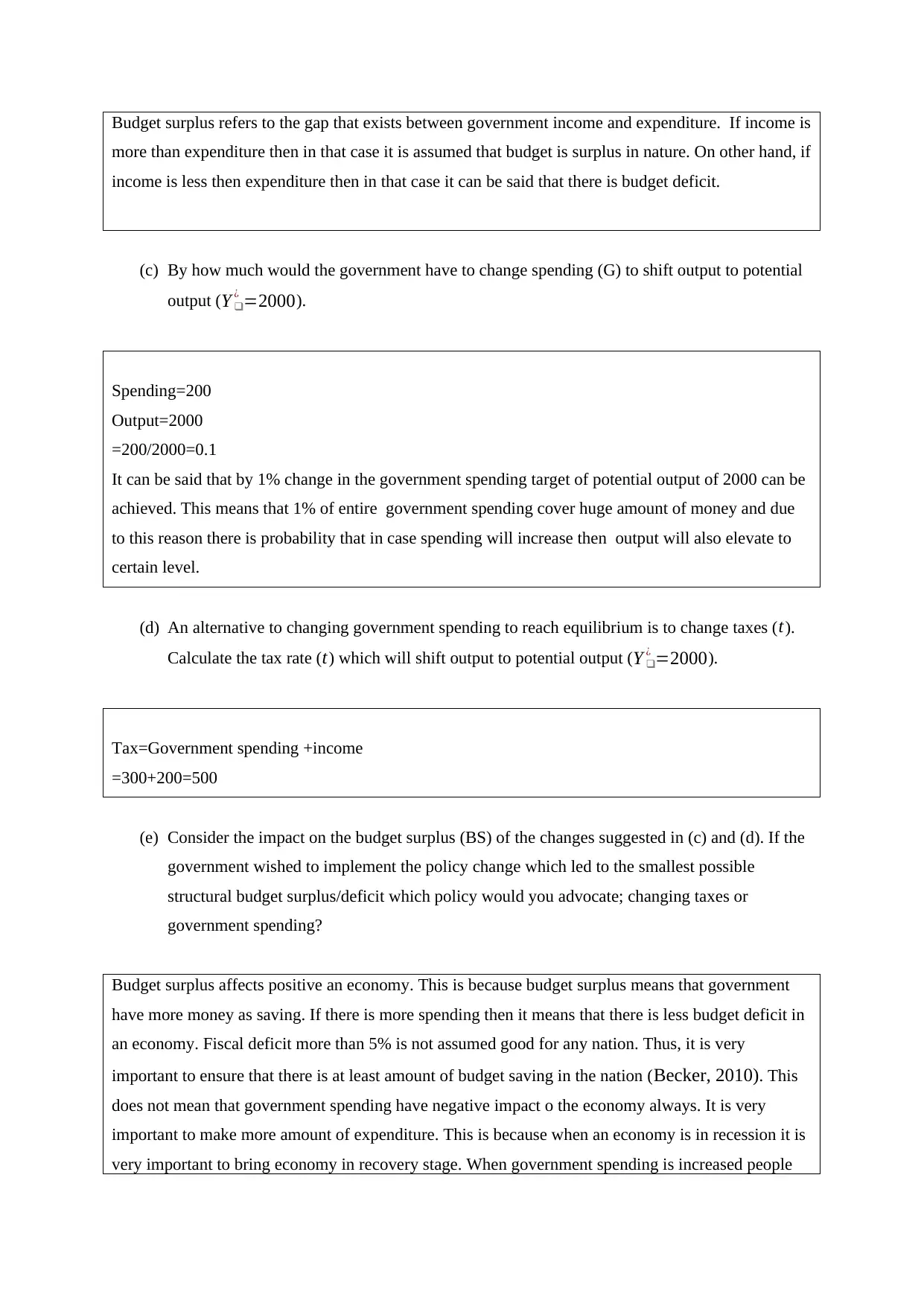
Budget surplus refers to the gap that exists between government income and expenditure. If income is
more than expenditure then in that case it is assumed that budget is surplus in nature. On other hand, if
income is less then expenditure then in that case it can be said that there is budget deficit.
(c) By how much would the government have to change spending (G) to shift output to potential
output ( Y ❑
¿ =2000).
Spending=200
Output=2000
=200/2000=0.1
It can be said that by 1% change in the government spending target of potential output of 2000 can be
achieved. This means that 1% of entire government spending cover huge amount of money and due
to this reason there is probability that in case spending will increase then output will also elevate to
certain level.
(d) An alternative to changing government spending to reach equilibrium is to change taxes ( t).
Calculate the tax rate (t) which will shift output to potential output ( Y ❑
¿ =2000).
Tax=Government spending +income
=300+200=500
(e) Consider the impact on the budget surplus (BS) of the changes suggested in (c) and (d). If the
government wished to implement the policy change which led to the smallest possible
structural budget surplus/deficit which policy would you advocate; changing taxes or
government spending?
Budget surplus affects positive an economy. This is because budget surplus means that government
have more money as saving. If there is more spending then it means that there is less budget deficit in
an economy. Fiscal deficit more than 5% is not assumed good for any nation. Thus, it is very
important to ensure that there is at least amount of budget saving in the nation (Becker, 2010). This
does not mean that government spending have negative impact o the economy always. It is very
important to make more amount of expenditure. This is because when an economy is in recession it is
very important to bring economy in recovery stage. When government spending is increased people
more than expenditure then in that case it is assumed that budget is surplus in nature. On other hand, if
income is less then expenditure then in that case it can be said that there is budget deficit.
(c) By how much would the government have to change spending (G) to shift output to potential
output ( Y ❑
¿ =2000).
Spending=200
Output=2000
=200/2000=0.1
It can be said that by 1% change in the government spending target of potential output of 2000 can be
achieved. This means that 1% of entire government spending cover huge amount of money and due
to this reason there is probability that in case spending will increase then output will also elevate to
certain level.
(d) An alternative to changing government spending to reach equilibrium is to change taxes ( t).
Calculate the tax rate (t) which will shift output to potential output ( Y ❑
¿ =2000).
Tax=Government spending +income
=300+200=500
(e) Consider the impact on the budget surplus (BS) of the changes suggested in (c) and (d). If the
government wished to implement the policy change which led to the smallest possible
structural budget surplus/deficit which policy would you advocate; changing taxes or
government spending?
Budget surplus affects positive an economy. This is because budget surplus means that government
have more money as saving. If there is more spending then it means that there is less budget deficit in
an economy. Fiscal deficit more than 5% is not assumed good for any nation. Thus, it is very
important to ensure that there is at least amount of budget saving in the nation (Becker, 2010). This
does not mean that government spending have negative impact o the economy always. It is very
important to make more amount of expenditure. This is because when an economy is in recession it is
very important to bring economy in recovery stage. When government spending is increased people
Paraphrase This Document
Need a fresh take? Get an instant paraphrase of this document with our AI Paraphraser
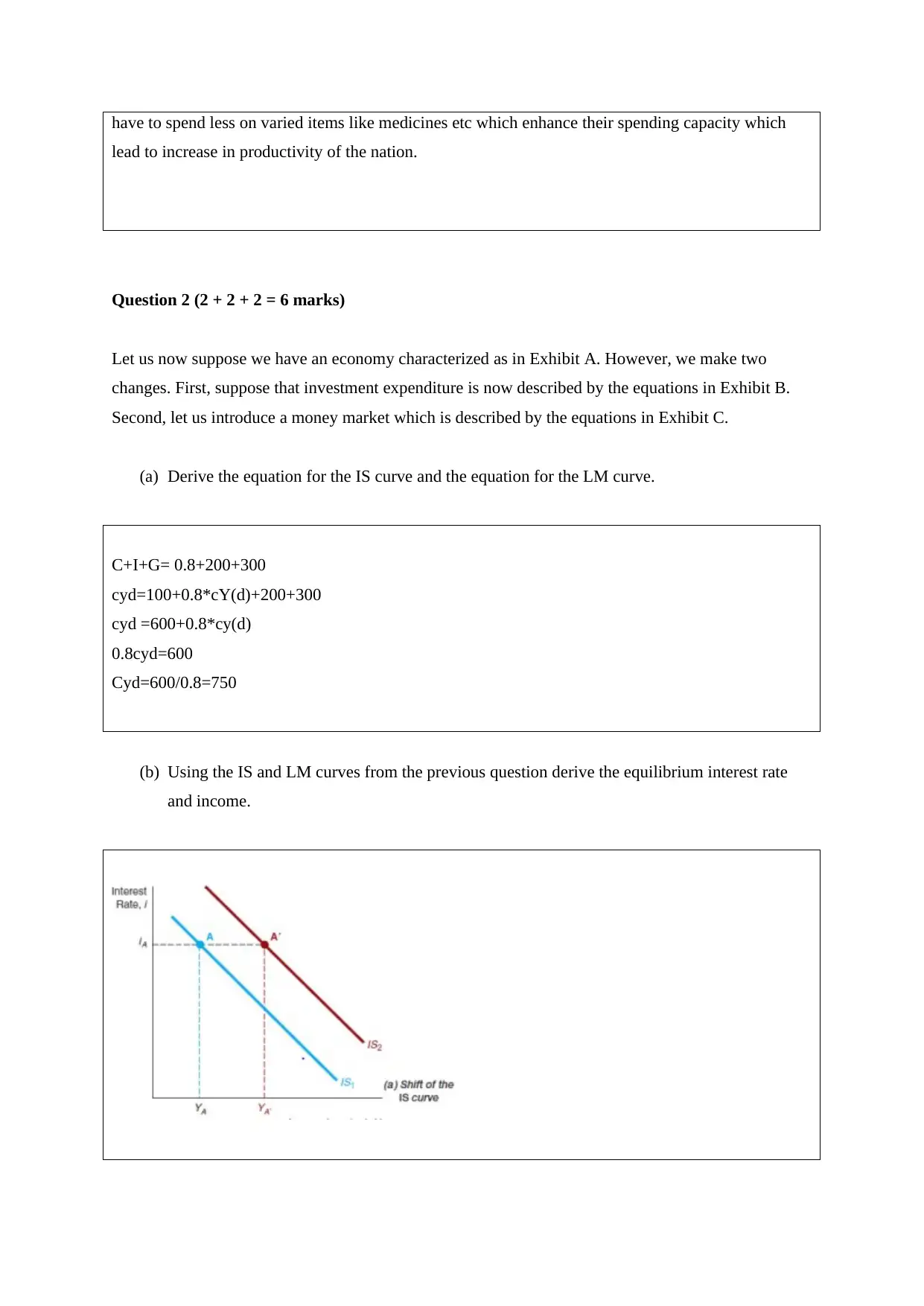
have to spend less on varied items like medicines etc which enhance their spending capacity which
lead to increase in productivity of the nation.
Question 2 (2 + 2 + 2 = 6 marks)
Let us now suppose we have an economy characterized as in Exhibit A. However, we make two
changes. First, suppose that investment expenditure is now described by the equations in Exhibit B.
Second, let us introduce a money market which is described by the equations in Exhibit C.
(a) Derive the equation for the IS curve and the equation for the LM curve.
C+I+G= 0.8+200+300
cyd=100+0.8*cY(d)+200+300
cyd =600+0.8*cy(d)
0.8cyd=600
Cyd=600/0.8=750
(b) Using the IS and LM curves from the previous question derive the equilibrium interest rate
and income.
lead to increase in productivity of the nation.
Question 2 (2 + 2 + 2 = 6 marks)
Let us now suppose we have an economy characterized as in Exhibit A. However, we make two
changes. First, suppose that investment expenditure is now described by the equations in Exhibit B.
Second, let us introduce a money market which is described by the equations in Exhibit C.
(a) Derive the equation for the IS curve and the equation for the LM curve.
C+I+G= 0.8+200+300
cyd=100+0.8*cY(d)+200+300
cyd =600+0.8*cy(d)
0.8cyd=600
Cyd=600/0.8=750
(b) Using the IS and LM curves from the previous question derive the equilibrium interest rate
and income.
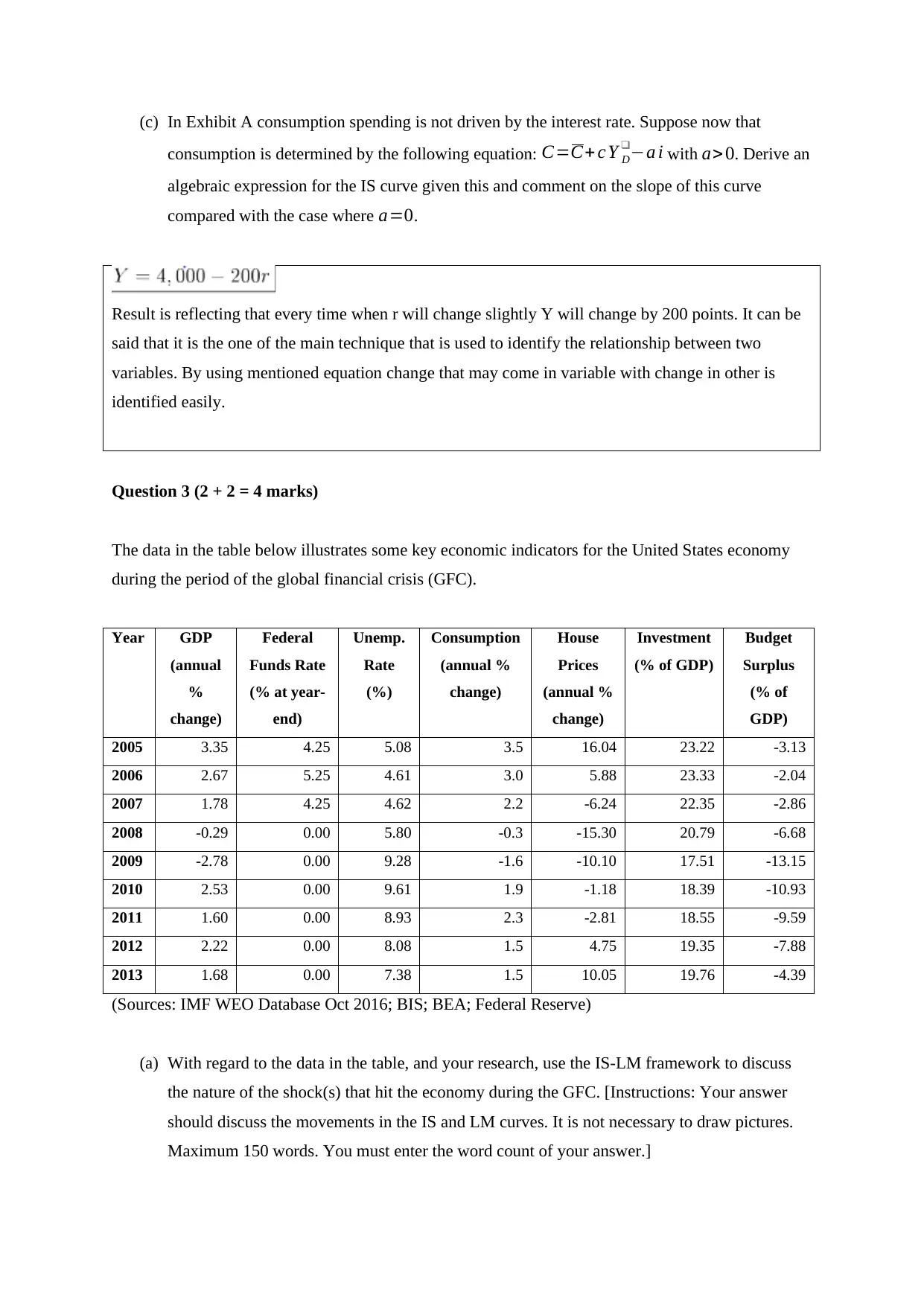
(c) In Exhibit A consumption spending is not driven by the interest rate. Suppose now that
consumption is determined by the following equation: C=C+ c Y D
❑−a i with a> 0. Derive an
algebraic expression for the IS curve given this and comment on the slope of this curve
compared with the case where a=0.
Result is reflecting that every time when r will change slightly Y will change by 200 points. It can be
said that it is the one of the main technique that is used to identify the relationship between two
variables. By using mentioned equation change that may come in variable with change in other is
identified easily.
Question 3 (2 + 2 = 4 marks)
The data in the table below illustrates some key economic indicators for the United States economy
during the period of the global financial crisis (GFC).
Year GDP
(annual
%
change)
Federal
Funds Rate
(% at year-
end)
Unemp.
Rate
(%)
Consumption
(annual %
change)
House
Prices
(annual %
change)
Investment
(% of GDP)
Budget
Surplus
(% of
GDP)
2005 3.35 4.25 5.08 3.5 16.04 23.22 -3.13
2006 2.67 5.25 4.61 3.0 5.88 23.33 -2.04
2007 1.78 4.25 4.62 2.2 -6.24 22.35 -2.86
2008 -0.29 0.00 5.80 -0.3 -15.30 20.79 -6.68
2009 -2.78 0.00 9.28 -1.6 -10.10 17.51 -13.15
2010 2.53 0.00 9.61 1.9 -1.18 18.39 -10.93
2011 1.60 0.00 8.93 2.3 -2.81 18.55 -9.59
2012 2.22 0.00 8.08 1.5 4.75 19.35 -7.88
2013 1.68 0.00 7.38 1.5 10.05 19.76 -4.39
(Sources: IMF WEO Database Oct 2016; BIS; BEA; Federal Reserve)
(a) With regard to the data in the table, and your research, use the IS-LM framework to discuss
the nature of the shock(s) that hit the economy during the GFC. [Instructions: Your answer
should discuss the movements in the IS and LM curves. It is not necessary to draw pictures.
Maximum 150 words. You must enter the word count of your answer.]
consumption is determined by the following equation: C=C+ c Y D
❑−a i with a> 0. Derive an
algebraic expression for the IS curve given this and comment on the slope of this curve
compared with the case where a=0.
Result is reflecting that every time when r will change slightly Y will change by 200 points. It can be
said that it is the one of the main technique that is used to identify the relationship between two
variables. By using mentioned equation change that may come in variable with change in other is
identified easily.
Question 3 (2 + 2 = 4 marks)
The data in the table below illustrates some key economic indicators for the United States economy
during the period of the global financial crisis (GFC).
Year GDP
(annual
%
change)
Federal
Funds Rate
(% at year-
end)
Unemp.
Rate
(%)
Consumption
(annual %
change)
House
Prices
(annual %
change)
Investment
(% of GDP)
Budget
Surplus
(% of
GDP)
2005 3.35 4.25 5.08 3.5 16.04 23.22 -3.13
2006 2.67 5.25 4.61 3.0 5.88 23.33 -2.04
2007 1.78 4.25 4.62 2.2 -6.24 22.35 -2.86
2008 -0.29 0.00 5.80 -0.3 -15.30 20.79 -6.68
2009 -2.78 0.00 9.28 -1.6 -10.10 17.51 -13.15
2010 2.53 0.00 9.61 1.9 -1.18 18.39 -10.93
2011 1.60 0.00 8.93 2.3 -2.81 18.55 -9.59
2012 2.22 0.00 8.08 1.5 4.75 19.35 -7.88
2013 1.68 0.00 7.38 1.5 10.05 19.76 -4.39
(Sources: IMF WEO Database Oct 2016; BIS; BEA; Federal Reserve)
(a) With regard to the data in the table, and your research, use the IS-LM framework to discuss
the nature of the shock(s) that hit the economy during the GFC. [Instructions: Your answer
should discuss the movements in the IS and LM curves. It is not necessary to draw pictures.
Maximum 150 words. You must enter the word count of your answer.]
⊘ This is a preview!⊘
Do you want full access?
Subscribe today to unlock all pages.

Trusted by 1+ million students worldwide
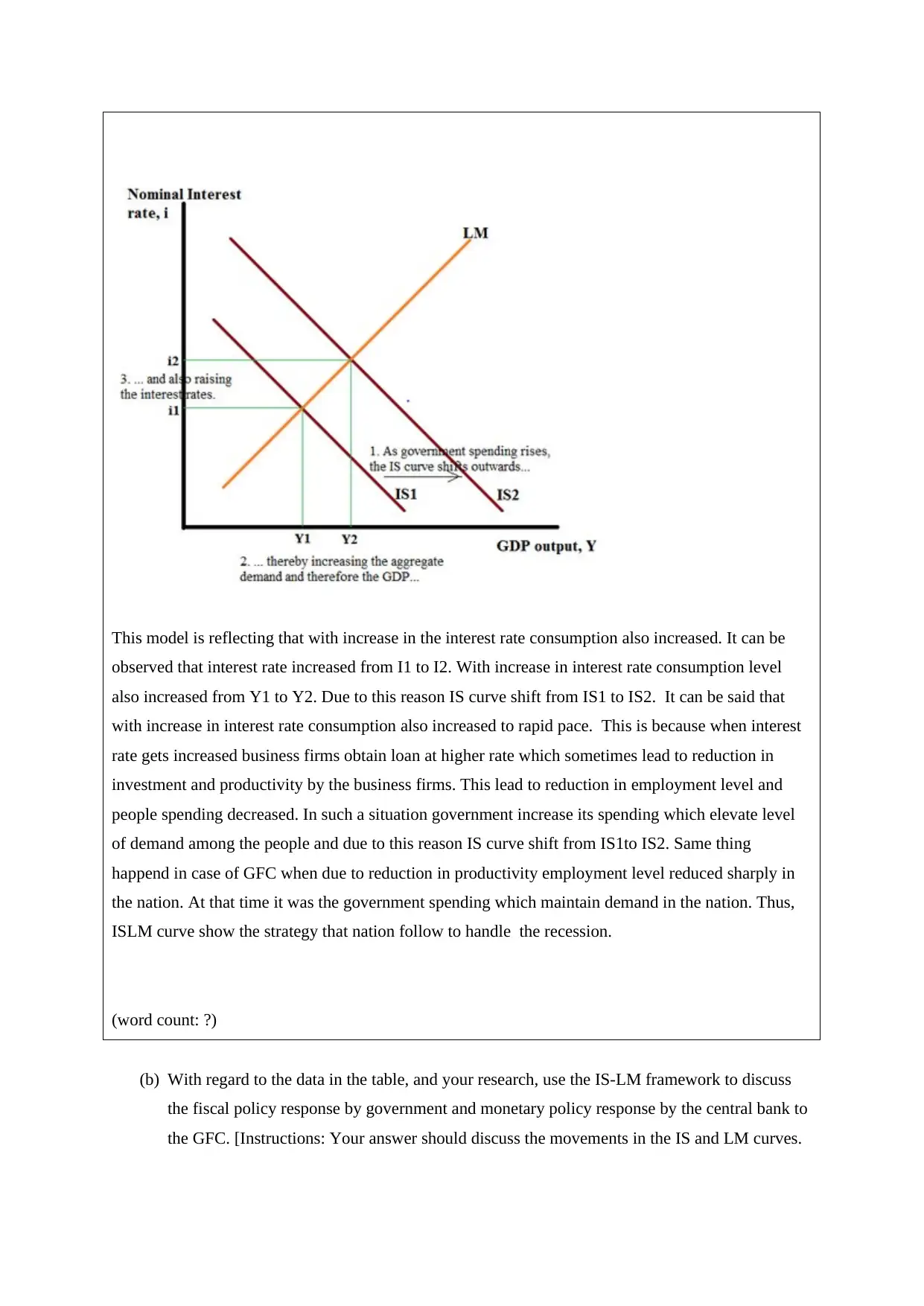
This model is reflecting that with increase in the interest rate consumption also increased. It can be
observed that interest rate increased from I1 to I2. With increase in interest rate consumption level
also increased from Y1 to Y2. Due to this reason IS curve shift from IS1 to IS2. It can be said that
with increase in interest rate consumption also increased to rapid pace. This is because when interest
rate gets increased business firms obtain loan at higher rate which sometimes lead to reduction in
investment and productivity by the business firms. This lead to reduction in employment level and
people spending decreased. In such a situation government increase its spending which elevate level
of demand among the people and due to this reason IS curve shift from IS1to IS2. Same thing
happend in case of GFC when due to reduction in productivity employment level reduced sharply in
the nation. At that time it was the government spending which maintain demand in the nation. Thus,
ISLM curve show the strategy that nation follow to handle the recession.
(word count: ?)
(b) With regard to the data in the table, and your research, use the IS-LM framework to discuss
the fiscal policy response by government and monetary policy response by the central bank to
the GFC. [Instructions: Your answer should discuss the movements in the IS and LM curves.
observed that interest rate increased from I1 to I2. With increase in interest rate consumption level
also increased from Y1 to Y2. Due to this reason IS curve shift from IS1 to IS2. It can be said that
with increase in interest rate consumption also increased to rapid pace. This is because when interest
rate gets increased business firms obtain loan at higher rate which sometimes lead to reduction in
investment and productivity by the business firms. This lead to reduction in employment level and
people spending decreased. In such a situation government increase its spending which elevate level
of demand among the people and due to this reason IS curve shift from IS1to IS2. Same thing
happend in case of GFC when due to reduction in productivity employment level reduced sharply in
the nation. At that time it was the government spending which maintain demand in the nation. Thus,
ISLM curve show the strategy that nation follow to handle the recession.
(word count: ?)
(b) With regard to the data in the table, and your research, use the IS-LM framework to discuss
the fiscal policy response by government and monetary policy response by the central bank to
the GFC. [Instructions: Your answer should discuss the movements in the IS and LM curves.
Paraphrase This Document
Need a fresh take? Get an instant paraphrase of this document with our AI Paraphraser
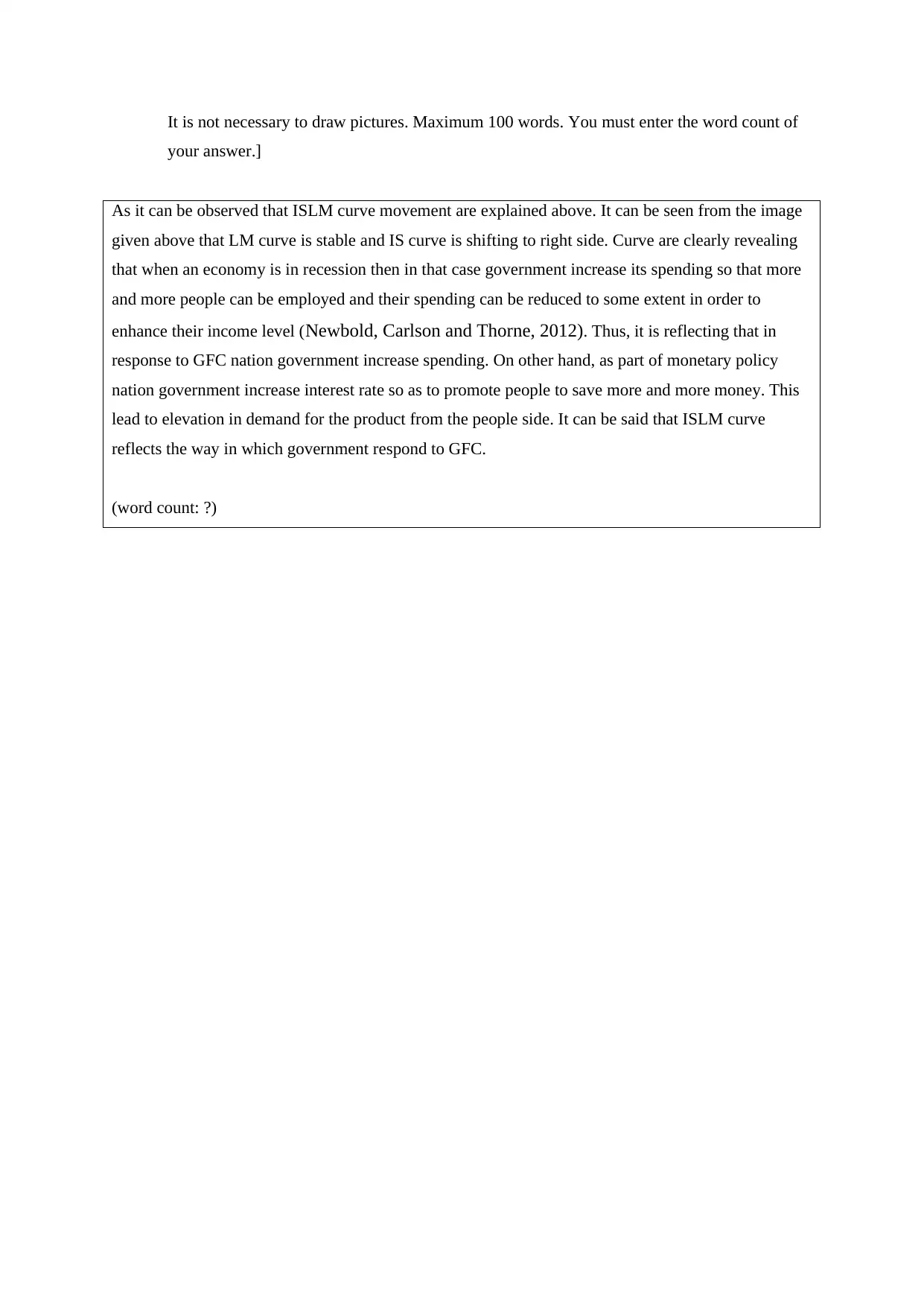
It is not necessary to draw pictures. Maximum 100 words. You must enter the word count of
your answer.]
As it can be observed that ISLM curve movement are explained above. It can be seen from the image
given above that LM curve is stable and IS curve is shifting to right side. Curve are clearly revealing
that when an economy is in recession then in that case government increase its spending so that more
and more people can be employed and their spending can be reduced to some extent in order to
enhance their income level (Newbold, Carlson and Thorne, 2012). Thus, it is reflecting that in
response to GFC nation government increase spending. On other hand, as part of monetary policy
nation government increase interest rate so as to promote people to save more and more money. This
lead to elevation in demand for the product from the people side. It can be said that ISLM curve
reflects the way in which government respond to GFC.
(word count: ?)
your answer.]
As it can be observed that ISLM curve movement are explained above. It can be seen from the image
given above that LM curve is stable and IS curve is shifting to right side. Curve are clearly revealing
that when an economy is in recession then in that case government increase its spending so that more
and more people can be employed and their spending can be reduced to some extent in order to
enhance their income level (Newbold, Carlson and Thorne, 2012). Thus, it is reflecting that in
response to GFC nation government increase spending. On other hand, as part of monetary policy
nation government increase interest rate so as to promote people to save more and more money. This
lead to elevation in demand for the product from the people side. It can be said that ISLM curve
reflects the way in which government respond to GFC.
(word count: ?)
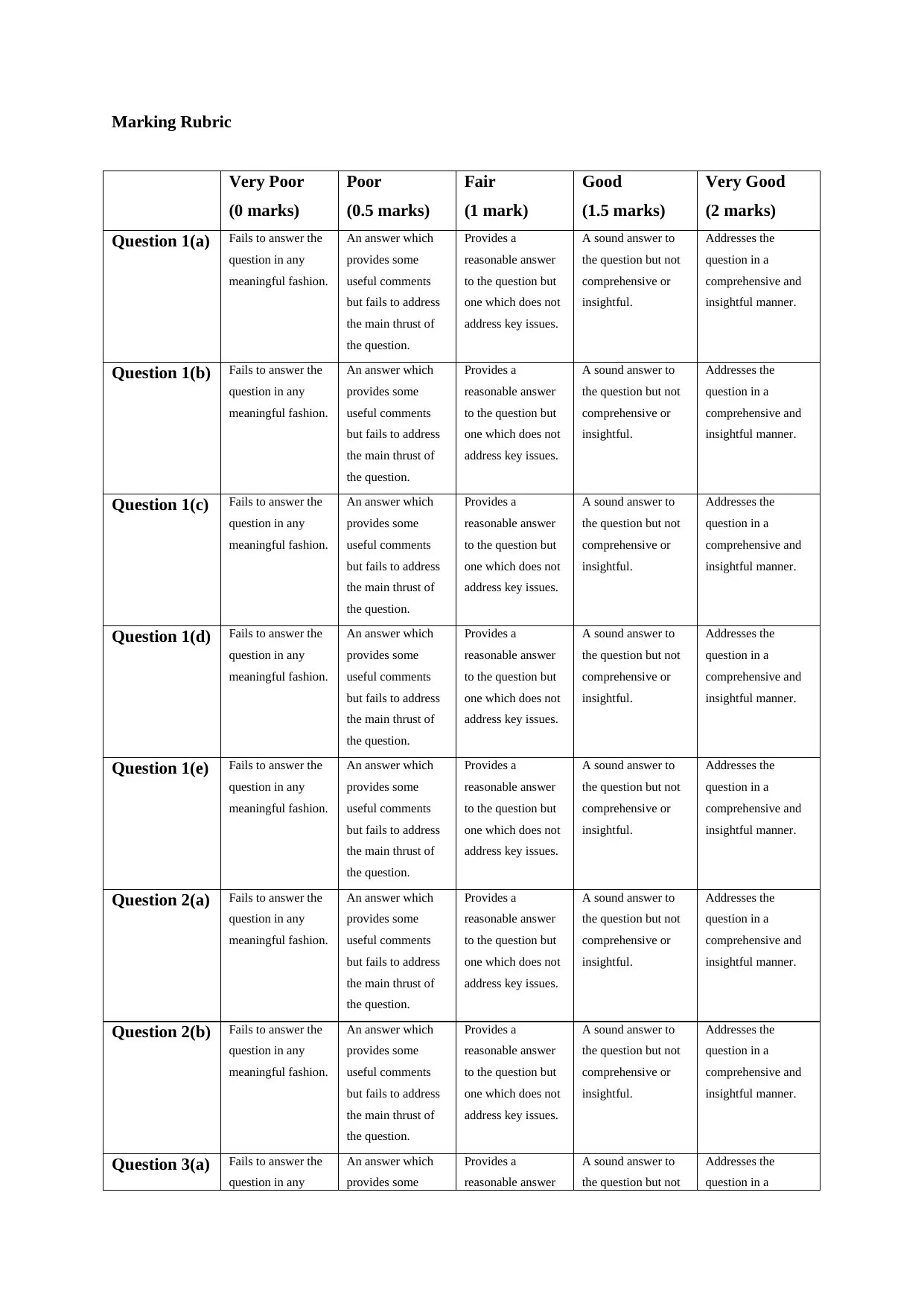
Marking Rubric
Very Poor
(0 marks)
Poor
(0.5 marks)
Fair
(1 mark)
Good
(1.5 marks)
Very Good
(2 marks)
Question 1(a) Fails to answer the
question in any
meaningful fashion.
An answer which
provides some
useful comments
but fails to address
the main thrust of
the question.
Provides a
reasonable answer
to the question but
one which does not
address key issues.
A sound answer to
the question but not
comprehensive or
insightful.
Addresses the
question in a
comprehensive and
insightful manner.
Question 1(b) Fails to answer the
question in any
meaningful fashion.
An answer which
provides some
useful comments
but fails to address
the main thrust of
the question.
Provides a
reasonable answer
to the question but
one which does not
address key issues.
A sound answer to
the question but not
comprehensive or
insightful.
Addresses the
question in a
comprehensive and
insightful manner.
Question 1(c) Fails to answer the
question in any
meaningful fashion.
An answer which
provides some
useful comments
but fails to address
the main thrust of
the question.
Provides a
reasonable answer
to the question but
one which does not
address key issues.
A sound answer to
the question but not
comprehensive or
insightful.
Addresses the
question in a
comprehensive and
insightful manner.
Question 1(d) Fails to answer the
question in any
meaningful fashion.
An answer which
provides some
useful comments
but fails to address
the main thrust of
the question.
Provides a
reasonable answer
to the question but
one which does not
address key issues.
A sound answer to
the question but not
comprehensive or
insightful.
Addresses the
question in a
comprehensive and
insightful manner.
Question 1(e) Fails to answer the
question in any
meaningful fashion.
An answer which
provides some
useful comments
but fails to address
the main thrust of
the question.
Provides a
reasonable answer
to the question but
one which does not
address key issues.
A sound answer to
the question but not
comprehensive or
insightful.
Addresses the
question in a
comprehensive and
insightful manner.
Question 2(a) Fails to answer the
question in any
meaningful fashion.
An answer which
provides some
useful comments
but fails to address
the main thrust of
the question.
Provides a
reasonable answer
to the question but
one which does not
address key issues.
A sound answer to
the question but not
comprehensive or
insightful.
Addresses the
question in a
comprehensive and
insightful manner.
Question 2(b) Fails to answer the
question in any
meaningful fashion.
An answer which
provides some
useful comments
but fails to address
the main thrust of
the question.
Provides a
reasonable answer
to the question but
one which does not
address key issues.
A sound answer to
the question but not
comprehensive or
insightful.
Addresses the
question in a
comprehensive and
insightful manner.
Question 3(a) Fails to answer the
question in any
An answer which
provides some
Provides a
reasonable answer
A sound answer to
the question but not
Addresses the
question in a
Very Poor
(0 marks)
Poor
(0.5 marks)
Fair
(1 mark)
Good
(1.5 marks)
Very Good
(2 marks)
Question 1(a) Fails to answer the
question in any
meaningful fashion.
An answer which
provides some
useful comments
but fails to address
the main thrust of
the question.
Provides a
reasonable answer
to the question but
one which does not
address key issues.
A sound answer to
the question but not
comprehensive or
insightful.
Addresses the
question in a
comprehensive and
insightful manner.
Question 1(b) Fails to answer the
question in any
meaningful fashion.
An answer which
provides some
useful comments
but fails to address
the main thrust of
the question.
Provides a
reasonable answer
to the question but
one which does not
address key issues.
A sound answer to
the question but not
comprehensive or
insightful.
Addresses the
question in a
comprehensive and
insightful manner.
Question 1(c) Fails to answer the
question in any
meaningful fashion.
An answer which
provides some
useful comments
but fails to address
the main thrust of
the question.
Provides a
reasonable answer
to the question but
one which does not
address key issues.
A sound answer to
the question but not
comprehensive or
insightful.
Addresses the
question in a
comprehensive and
insightful manner.
Question 1(d) Fails to answer the
question in any
meaningful fashion.
An answer which
provides some
useful comments
but fails to address
the main thrust of
the question.
Provides a
reasonable answer
to the question but
one which does not
address key issues.
A sound answer to
the question but not
comprehensive or
insightful.
Addresses the
question in a
comprehensive and
insightful manner.
Question 1(e) Fails to answer the
question in any
meaningful fashion.
An answer which
provides some
useful comments
but fails to address
the main thrust of
the question.
Provides a
reasonable answer
to the question but
one which does not
address key issues.
A sound answer to
the question but not
comprehensive or
insightful.
Addresses the
question in a
comprehensive and
insightful manner.
Question 2(a) Fails to answer the
question in any
meaningful fashion.
An answer which
provides some
useful comments
but fails to address
the main thrust of
the question.
Provides a
reasonable answer
to the question but
one which does not
address key issues.
A sound answer to
the question but not
comprehensive or
insightful.
Addresses the
question in a
comprehensive and
insightful manner.
Question 2(b) Fails to answer the
question in any
meaningful fashion.
An answer which
provides some
useful comments
but fails to address
the main thrust of
the question.
Provides a
reasonable answer
to the question but
one which does not
address key issues.
A sound answer to
the question but not
comprehensive or
insightful.
Addresses the
question in a
comprehensive and
insightful manner.
Question 3(a) Fails to answer the
question in any
An answer which
provides some
Provides a
reasonable answer
A sound answer to
the question but not
Addresses the
question in a
⊘ This is a preview!⊘
Do you want full access?
Subscribe today to unlock all pages.

Trusted by 1+ million students worldwide
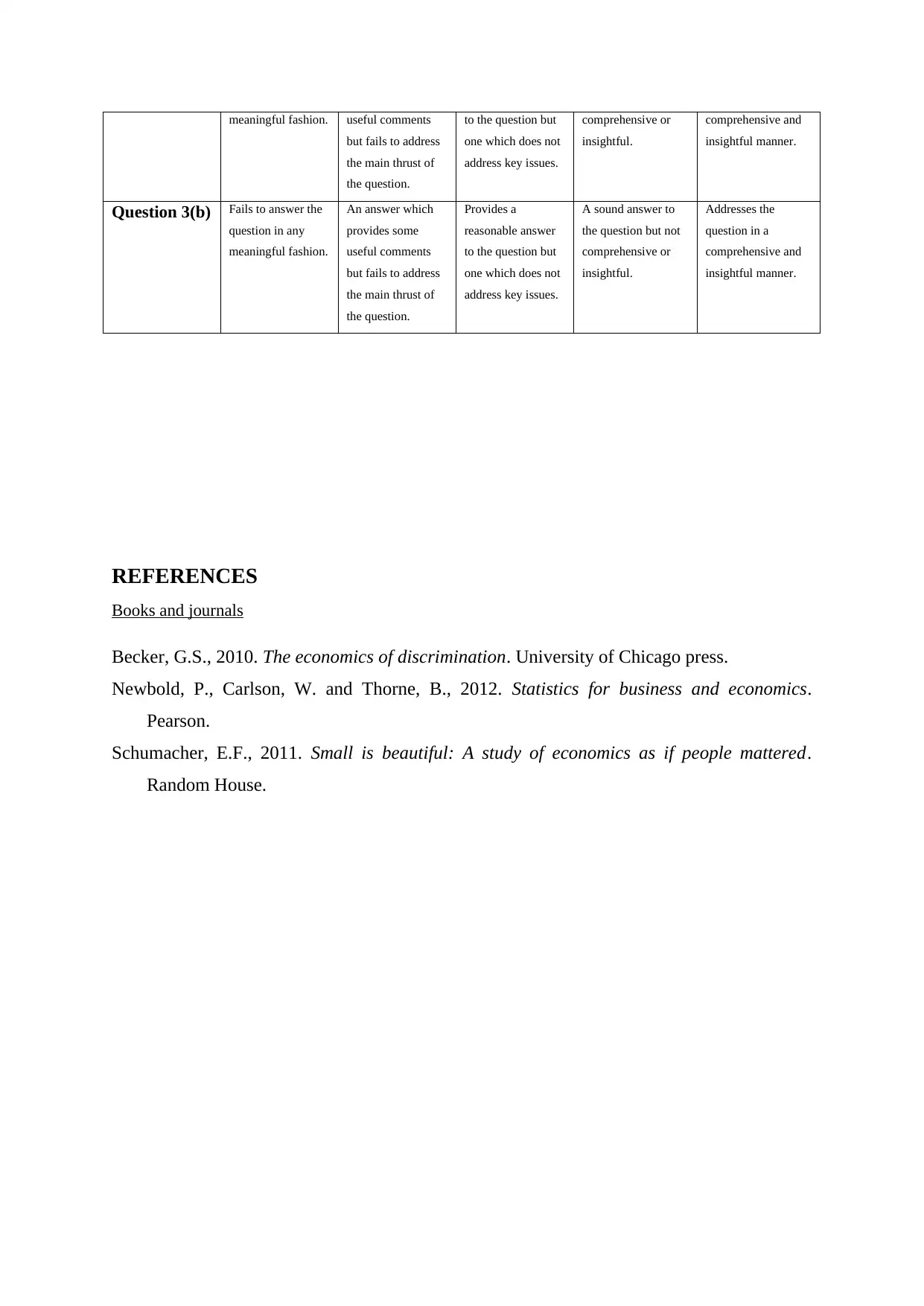
meaningful fashion. useful comments
but fails to address
the main thrust of
the question.
to the question but
one which does not
address key issues.
comprehensive or
insightful.
comprehensive and
insightful manner.
Question 3(b) Fails to answer the
question in any
meaningful fashion.
An answer which
provides some
useful comments
but fails to address
the main thrust of
the question.
Provides a
reasonable answer
to the question but
one which does not
address key issues.
A sound answer to
the question but not
comprehensive or
insightful.
Addresses the
question in a
comprehensive and
insightful manner.
REFERENCES
Books and journals
Becker, G.S., 2010. The economics of discrimination. University of Chicago press.
Newbold, P., Carlson, W. and Thorne, B., 2012. Statistics for business and economics.
Pearson.
Schumacher, E.F., 2011. Small is beautiful: A study of economics as if people mattered.
Random House.
but fails to address
the main thrust of
the question.
to the question but
one which does not
address key issues.
comprehensive or
insightful.
comprehensive and
insightful manner.
Question 3(b) Fails to answer the
question in any
meaningful fashion.
An answer which
provides some
useful comments
but fails to address
the main thrust of
the question.
Provides a
reasonable answer
to the question but
one which does not
address key issues.
A sound answer to
the question but not
comprehensive or
insightful.
Addresses the
question in a
comprehensive and
insightful manner.
REFERENCES
Books and journals
Becker, G.S., 2010. The economics of discrimination. University of Chicago press.
Newbold, P., Carlson, W. and Thorne, B., 2012. Statistics for business and economics.
Pearson.
Schumacher, E.F., 2011. Small is beautiful: A study of economics as if people mattered.
Random House.
1 out of 10
Related Documents
Your All-in-One AI-Powered Toolkit for Academic Success.
+13062052269
info@desklib.com
Available 24*7 on WhatsApp / Email
![[object Object]](/_next/static/media/star-bottom.7253800d.svg)
Unlock your academic potential
Copyright © 2020–2025 A2Z Services. All Rights Reserved. Developed and managed by ZUCOL.




